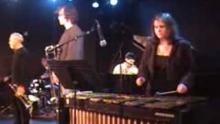Terry Gibbs and Terry Pollard. This is nothing short of incredible!!!
Oh man this is so unbelievable. Terry Pollard is a smoking pianist and then she gets on the vibes and tears it up with Terry Gibbs. And Gibbs is a monster on this!!!
I died when i heard this!!!
Happy Birthday Milt!
It was Milt's Birthday, Jan, 1st (right?).
- Read more about Happy Birthday Milt!
- 3 comments
- Log in or register to post comments
You want more incentive
THE WOMEN ARE COMING, THE WOMEN ARE COMING!!
OK guys, they are still coming at ya. This time this lady is soloing while reading down the chart. Notice how she concentrates on the chart and only occasionally looks down at the bars. Watch out, I tell ya they are coming!
There is also no information on this video. Looks like maybe a college concert. She has her cheering section.
BruceW
:-)
- Read more about You want more incentive
- 3 comments
- Log in or register to post comments
Hey you guys, watch out
All you guys who are getting too comfortable with your vibraphone jazz progress, better watch out. Here is another female getting awfully close to the top (is young and has time on her side). There is no information on this video (strange) so I also do not know who she is or exactly where she is from except that she is Oriental. She looks kind of short but that is not stopping her. They are apparently playing a Bud Powell tune and two standards that have been edited into short excerpts.
But at any rate, bravo.
BruceW
:-)
- Read more about Hey you guys, watch out
- 11 comments
- Log in or register to post comments
Music keeps you young - Two cool examples
Recovering from New Year Eve, my men and I, laying on the sofa we discovered that amazing testimony that age, generations, music and energy can truly get together! Just go to this link of the French TV and let it load to choose the best parts: http://videos.tf1.fr/reportages/rock-n-roll-attitude-5598893.html
Raphael, the Belgian "Pappy Blues": from 9:08 to 17:25
- Read more about Music keeps you young - Two cool examples
- Log in or register to post comments
Think Energy for the New Year
Man I do a lot of vibe talking because of this site. It's pretty incredible and sort of a dream come true. We live pretty isolated lives don't we?
One topic that has come up recently is acheiving your goals. I go straight to the word energy when I hear the word goals.
To achieve a goal is going to take energy and for most of us a LOT of energy (I've said it before, haven't I?). But if you put the right energy in I think most of our goals are achievable. Now that being said we all have to be reasonable.
- Read more about Think Energy for the New Year
- 6 comments
- Log in or register to post comments
Check Out This Groove!
This is so grooving it's killing me!
- Read more about Check Out This Groove!
- 3 comments
- Log in or register to post comments
Using Loops to Practice by Tony Miceli -V
Do you use sequencers to practice. Man, they can be very helpful. Loops are a great way to practice. But even making up loops without the sequencer and playing them in a solo vibes format can be really help you're playing.
So, I talk about loops in this lesson.
- Read more about Using Loops to Practice by Tony Miceli -V
- Log in or register to post comments
Hippify Your Voicings! by Tony Miceli
I posted a pdf to go along this. It's attached below.
- Read more about Hippify Your Voicings! by Tony Miceli
- 1 comment
- Log in or register to post comments






